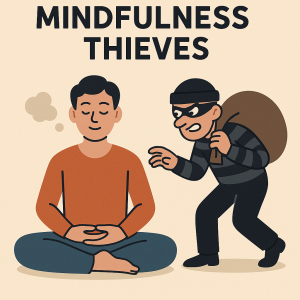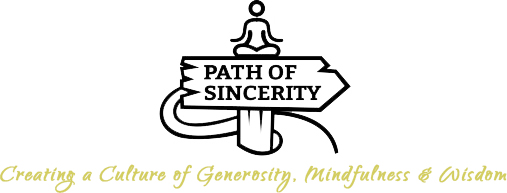
The following reflection originally appeared in the newsletter I sent out on December 7th, 2024.
Feel free to read just the bold words and skip the rest.
Introduction
I talk to a lot of meditators who tell a similar story.
They say they sit to meditate, but have a hard time or feel like they are just plain bad at it, because something always comes and steals their mindfulness away! Usually it’s thoughts, but can also include physical discomfort/pain, strong emotions, loud sounds, and sleepiness, among other possibilities.
Especially with thoughts, meditators quickly get engaged in a battle where thoughts are the enemy. Maybe the first handful of times they get lost in thought, they are pretty mellow about it. But then it crosses an arbitrary threshold called “too much.” From that point, every time it happens, they become frustrated, doubt themselves, get tense, and/or start ping ponging their meditation to different methods in hopes of removing the thief.
When we talk, they ask me, “what can I do? What technique to use? Mantra? Counting? Breathing focusing? Reflection? Some secret something? Magic?”
Basically, they want to know how to fix the problem.
Start from the Foundation
Usually, these questions are rooted in an underlying view that the point of meditation is achieve a state — like peace, no-thoughts, calm, focus, and so on. Likewise, this view says that anything in the way of that goal is a problem/enemy, whether it’s thoughts, pain, or anything else. When those “enemies” inevitably arise, this naturally prompts frustration, doubt and the problem-solving mind.
Rather than buy into that paradigm, the key is to start from a completely different foundation — that the purpose of meditation is to understand what is.
In nerd speak, we meditate in order to understand the nature of reality. The nature of mind and body. The nature of cause and effect. How phenomena arise and pass, how when we grasp or resist we suffer, and how nothing observable, including thoughts or pain or moods, is me or mine.
You might read the above paragraph and think, “huh?”
In more plain speak, we assume a curious, allowing, and perseverant attitude — a learning mindset.
For example, when the thoughts are chaotic, we can learn from that too. We may think, “how interesting — this is what a thought storm is like! The body feels like this! The impact they have on emotions is like that!” Maybe we even start to observe the desire to think, like the moment we just exited a thought but notice a compulsive force that wants to think about it more. Over time, maybe we see the subtler ways that we get involved with thoughts and perpetuate them. Or maybe we gain some insight into the fruitless and optional way we resist and react to thoughts. Maybe we see the sense of self that underlies the thoughts, or the moods/emotions from which thoughts spring.
It’s not that you’re asking all these questions or turning meditation into some big project, but rather that we’re perseveringly paying attention. The more we do this, we accumulate understanding, which blossoms into wisdom, freedom, and an authentic capacity to release or engage.
My teacher has described this process as like watching a TV show. If we just sit and watch a whole season, we’re going to intuitively understand the many storylines, who the characters are, the deeper context, and so on. We don’t need to think about it. We don’t need to ask a lot of questions. We just need to consistently watch the show.
In the same way, our task is to consistently observe our experience, whether quiet or chaotic, when comfortable or uncomfortable, whether sleepy or alert, whether distracted by sounds or not. We continually observe, “what’s this like?” A learning mindset.
The Objection
When I share the above, people sometimes say, “yeah but I can’t do any of that because I’m so lost in thoughts, consumed by the pain, swirling in the emotion, etc.!”
Okay, well what’s that like!?
Are you 100% lost/consumed/swirling, or are there even seconds here and there where you’re not? What does that feel like? Is it the same every time you meditate or does it differ from day-to-day? Even if it’s pretty intense, what do you learn through spending a period of meditation just sticking with it? Whatever you can notice, this is good!
Alternatively, when I was a monk, I overheard someone asking my teacher, Sayadaw U Tejaniya, this question, “how do I make my excessively wandering mind stop?”
Sayadaw thought for a few moments, and then said, “how long have you been here at the monastery?”
The man said, “nine days.” Sayadaw replied, “and how old are you?” He said, “65 years old.”
Sayadaw paused, and then said, “Nine days meditating all the time, 65 years thinking all the time, what do you expect!?”
The point of sharing this is that we can’t just magically transform our mind or experience. The power of conditioning is real. There is no special technique that’s going to all of sudden make all your thoughts go away or make the pain disappear if they been deeply conditioning in your mind over a long stretch of time.
However, through engaging in a long-term process of paying attention, learning, and digesting, we do slowly transform our minds & lives. Every so often there may be a dramatic insight / letting go that happens, but even here, it’s almost always the byproduct of a lot of behind-the-scenes build up.
I often reflect how the Dalai Lama said to evaluate spiritual practice in five year intervals — not five day or even five month intervals. In other words, transformation happens, but it takes time.
The Pendulum
Imagine a pendulum that swings between too serious/striving on one side and too apathetic/checked-out on the other side.
When people think in terms of “this problem is stealing my mindfulness,” they usually swing to the too serious/striving side, and spend lots of their meditation time feeling agitated about the so-called thief.
However, once people start to let go of that view, the temptation is to swing really hard to the other side, and think, “if it’s fine to get lost in thoughts, I’ll completely let go of effort and just sit here until the bell rings.” But this is just another imbalance!
Instead, as I said earlier, we find balance through entering an allowing, curious and perseverant attitude. Whatever happens is allowed to be here. Nothing, and I mean nothing, is out of bounds for a “good meditation.” It’s all reality. Pain happens. Rage happens. Shame happens. Thought storms happen. Sexual fantasy happens. Vomiting happens. None of that is a problem — it’s just what it is. We can observe it like the TV show. Not with a bunch of thoughts, but with perseverant attention.
And from that foundation, we can absolutely use a “method,” like mindfulness of breathing, mantra, body scan, open awareness, or anything else. However, the point is no longer to destroy the so-called thieves. Rather, it’s to give ourselves a gentle grounding in presence from which to observe how it is.
It’s probably not going to be perfect, and that’s fine. The point isn’t perfection, but refining our orientation.
This approach lends itself to a more playful experience of meditation. It’s no longer this high-stakes, very serious endeavor. As the name of my website goes, it’s sincere but not serious.
In that space, we can try experiments. What happens if I count breaths or if get interested in the flow of exhale, gap, inhale, repeat? What happens if my back really hurts, but rather than be consumed by reactivity, I zoom out and notice the breath is still here? Or what if I zoom in and notice all the little micro-sensations of the pain with a relaxed engagement? Taking delight in the noticing/learning, rather than the feel-good-outcome!
Slowly slowly, we glide into that center point of the pendulum where we’re relaxed yet alert, curious yet allowing, grounded yet engaged. As a tip for arriving at balance, meditate more, try to figure it out less.
Conclusion
Thoughts are not the enemy! Neither are physical discomfort/pain, emotions, sounds, or sleepiness! They aren’t even thieves!
These are just other facets of reality to be observed. Right now, it’s like this.
When you start from a foundation of allowing, curiosity, and perseverance, your meditation practice is on track to produce more learning and ease in your own skin. Reality becomes more and more of a simple, pleasant abiding in the here and now. And from that, there is so much energy freed up to love, serve, and spend your time on the things you care most deeply about.
As a note, my favorite meditation book of all time captures some of the flavor of this reflection quite well: Relax & Be Aware by Sayadaw U Tejaniya.
—————
If you would like to get a monthly’ish email with reflections like this one, along with some event updates, sign up here for the newsletter.
